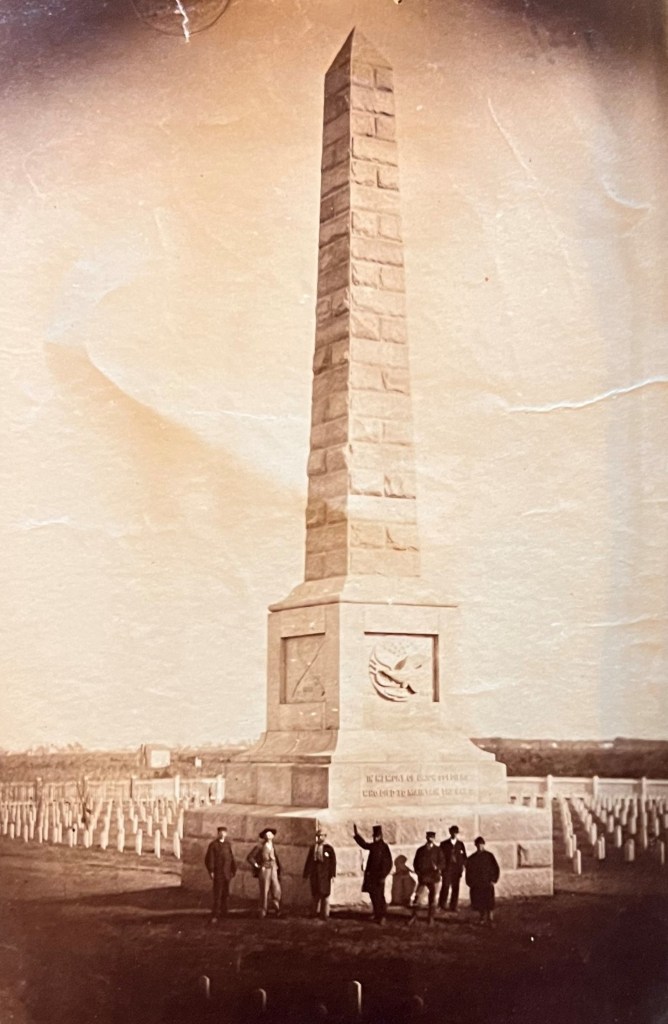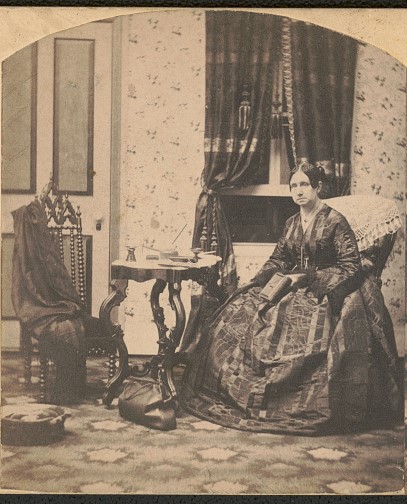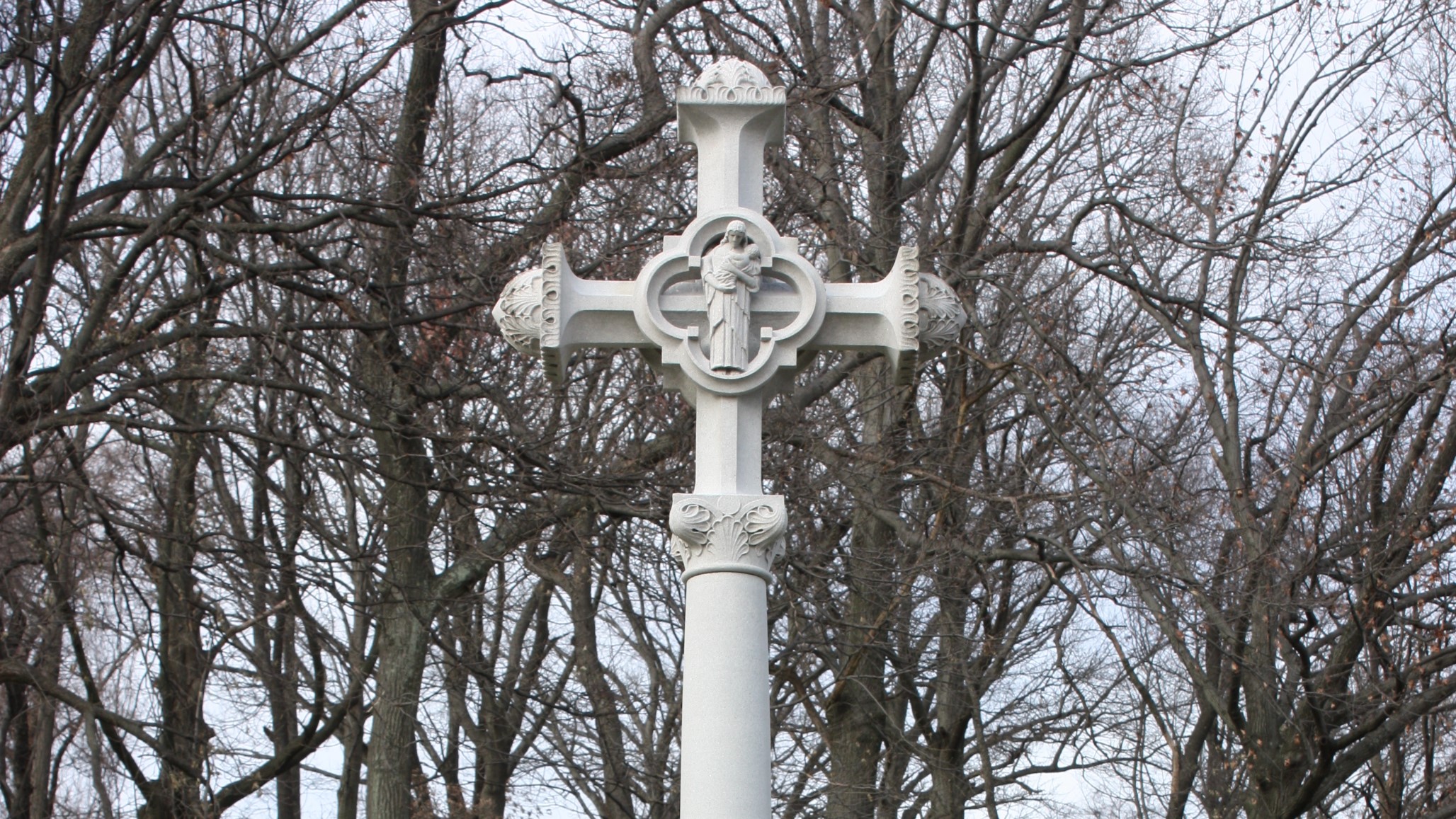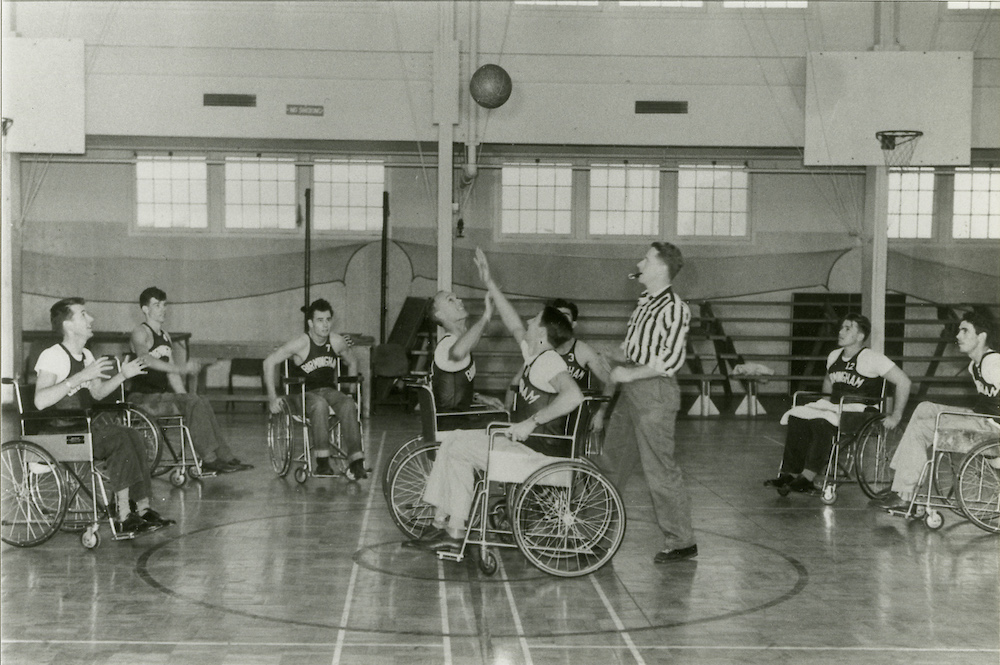
On May 12, 1868, Dorothea L. Dix transferred ownership of the newly installed monument at Hampton National Cemetery in Virginia to the U.S. Army. Dedicated to “Union Soldiers who perished in the War of the Rebellion,” the 65-foot-tall granite obelisk is among the largest and earliest Civil War memorials in VA’s national cemetery system. After the war, Army officials consolidated the graves of all Union soldiers in southeastern Virginia at the Hampton site. However, plans to erect a monument there using private donations almost failed until Dix—renowned social reformer, mental health advocate, and Superintendent of Army Nurses during the Civil War—took charge of the effort. Credit for the Union Soldiers’ Monument belongs entirely to Dix. Through her determined fundraising and generosity with her own time and money, she rescued the faltering memorial project and shepherded it to completion.
Union chaplains James Marshall and Edward P. Roe at the Fort Monroe military hospital conceived of the idea of raising a monument for soldiers at the nearby cemetery in early 1865. They established a fundraising board that included themselves and the assistant surgeon. However, the publication of two circulars in national newspapers soliciting donations raised only $1,000, well short of their $4,000 goal. In the spring of 1866, the board sought out Dix, who had close associations with the Fort Monroe hospital. She personally pledged $1,000 and quietly secured another $3,000 in donations. By August 1866, the board officially dissolved and asked Dix to assume responsibility for “carrying forward and completing the monument.” Within two months, based on personal connections alone, Dix collected $7,900. Now flush with funds, she worked with Army engineers to visit northeast quarries and solicit bids. Soon after, she entered into a contract for granite with Ira Andrews of Biddeford, Maine, who agreed to deliver the materials to Hampton by April 1867.
Dix originally planned for a modest 30-foot-tall obelisk. The money raised would be sufficient to cover the costs of quarrying and transporting the granite to Hampton and constructing the actual monument. In the summer of 1866, however, Quartermaster General Montgomery C. Meigs committed the Army to paying for the transportation and construction, since the monument upon completion would be gifted to the U.S. government. This arrangement allowed Dix to increase the monument’s height to 75 feet, with a base nearly 20 feet square. It also gave her the financial resources to pay for more ornamentation: a high-relief U.S. coat-of-arms with a life-size eagle on the front, and three other panels inscribed with a cross-cannon (artillery), cross-sabre (cavalry), and cross-rifle (infantry). Brevet Lieutenant Colonel Thomas J. Treadwell, serving as Principal Assistant to the Army’s Chief of Ordnance, suggested the addition of large block dates to accompany the imagery to signify different periods of the war. The inscription below the face panel—“In memory of Union Soldiers who died to maintain the Laws”—was inspired by the classical Greek couplet honoring the Spartan warriors who died at the Battle of Thermopylae: “Go tell in Lacedaemon [Sparta] these died to maintain the laws.”* The completed monument weighed 700 tons. Dix hoped to place it on a sand ridge surrounded by live oak trees a mile north of Fort Monroe overlooking the Chesapeake Bay. The Engineering Corps overruled her because the site was part of an artillery range and the monument would be at risk. Instead, the obelisk was located on the cemetery grounds amid the neat rows of headstones.

Work on the monument proceeded as planned and, in March 1867, the quarry notified Dix that the monument blocks would be ready to ship the following month. Before the blocks could be transported, however, she learned from the Quartermaster offices in Boston and Hampton that the movement order was repealed. Dix travelled to Washington in May to resolve the problem and found that an ailing Meigs had asked his acting, General Daniel Rucker, to finalize the project. Rucker balked at fulfilling Meigs’ agreement to pay the $4,000 necessary to cover the transportation and construction costs. Rucker brought the issue to Secretary of War Edwin M. Stanton for resolution. While sympathetic to Dix’s cause, Stanton sided with Rucker. He determined that Meigs had exceeded his authority and that no government funds would be allocated.
Having exhausted the budget on a more elaborate design, Dix once again took matters into her own hands. She used her personal funds to finish the monument without bothering to seek further donations. (The government belatedly made good on Meigs’ promise and reimbursed Dix for expenses totaling $4,949 in 1872.) A crowd turned out to witness the laying of the monument cornerstone on October 3, 1867. Installation of the capstone took place on November 28. A few weeks later, the machinery was removed and the workers departed. Although dedication of the monument would not occur until the following year, Dix’s task was complete. She had raised an enduring monument to the thousands of Union soldiers buried at the national cemetery. In later years, Union Veterans residing at the nearby Southern Branch of the National Home for Disabled Volunteer Soldiers would, upon their passing, be laid to rest there, too, within sight of the memorial to their fallen brethren.
* A prominent Philadelphia judge suggested the quote to Dix and he probably supplied his own translation from the Greek.
By Richard Hulver, Ph.D.
Historian, National Cemetery Administration
Share this story
Related Stories
History of VA in 100 Objects
In the waning days of World War I, French sailors from three visiting allied warships marched through New York in a Liberty Loan Parade. The timing was unfortunate as the second wave of the influenza pandemic was spreading in the U.S. By January, 25 of French sailors died from the virus.
These men were later buried at the Cypress Hills National Cemetery and later a 12-foot granite cross monument, the French Cross, was dedicated in 1920 on Armistice Day. This event later influenced changes to burial laws that opened up availability of allied service members and U.S. citizens who served in foreign armies in the war against Germany and Austrian empires.
History of VA in 100 Objects
Basketball is one of the most popular sports in the nation. However, for paraplegic Veterans after World War II it was impossible with the current equipment and wheelchairs at the time. While VA offered these Veterans a healthy dose of physical and occupational therapy as well as vocational training, patients craved something more. They wanted to return to the sports, like basketball, that they had grown up playing. Their wheelchairs, which were incredibly bulky and commonly weighed over 100 pounds limited play.
However, the revolutionary wheelchair design created in the late 1930s solved that problem. Their chairs featured lightweight aircraft tubing, rear wheels that were easy to propel, and front casters for pivoting. Weighing in at around 45 pounds, the sleek wheelchairs were ideal for sports, especially basketball with its smooth and flat playing surface. The mobility of paraplegic Veterans drastically increased as they mastered the use of the chair, and they soon began to roll themselves into VA hospital gyms to shoot baskets and play pickup games.
History of VA in 100 Objects
After World War I, claims for disability from discharged soldiers poured into the offices of the Bureau of War Risk Insurance, the federal agency responsible for evaluating them. By mid-1921, the bureau had awarded some amount of compensation to 337,000 Veterans. But another 258,000 had been denied benefits. Some of the men turned away were suffering from tuberculosis or neuropsychiatric disorders. These Veterans were often rebuffed not because bureau officials doubted the validity or seriousness of their ailments, but for a different reason: they could not prove their conditions were service connected.
Due to the delayed nature of the diseases, which could appear after service was completed, Massachusetts Senator David Walsh and VSOs pursued legislation to assist Veterans with their claims. Eventually this led to the first presumptive conditions for Veteran benefits.






